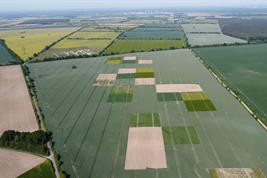20.11.2024

A current research paper in the European Journal of Agronomy highlights the most important research priorities that are necessary in order to use digital technologies more efficiently for sustainable crop production in the future. With the participation of the Leibniz Centre for Agricultural Landscape Research (ZALF), an international research team investigated how smart technologies such as artificial intelligence (AI), robotics and sensor technology can make agriculture more sustainable as part of the PhenoRob Cluster of Excellence.
Agriculture is faced with the challenge of meeting the growing demand for food and raw materials with limited resources while at the same time reducing the environmental impact. Digital technologies offer great potential for mastering this balancing act. Research determines which priorities should be set in the future in order to maximize the impact of such technologies in practice and increase acceptance among farmers. In particular, ZALF contributes to the development of new field arrangements and corresponding models and decision-making tools that optimize production processes and enable targeted cultivation recommendations.
"Our research shows that the use of smart digital technologies can fundamentally change crop production. Through improved and combined sensor technology, data collection and use, and modeling, we can make agricultural decisions more precise and resource-efficient," explains Prof. Dr. Frank Ewert, Scientific Director of ZALF. "In this way, we are not only contributing to productivity, but also to environmental protection."
Four central fields of research
In order to unlock the potential of smart technologies for agriculture, the researchers identified four key areas in which further research is needed:
-
Multi-sensor monitoring: Digital technologies should use multi-sensor systems to record the condition of plants and soil precisely and in real time. Optical methods such as hyperspectral imaging or laser scanning detect the smallest changes and signs of disease at an early stage and enable detailed monitoring down to plant level. Another goal is the development of new sensors for the non-invasive detection of root systems and their distribution in the field.
-
Combination of data and process models: The combination of data-based and process-driven models is crucial to develop accurate and scalable agricultural system models. This allows detailed predictions to be made about plant development and nutrient requirements under specific environmental conditions. With the help of AI and machine learning, models should also be linked in such a way that they better support concrete management decisions, such as the use of fertilizers.
-
Improving decision-making and intervention: Smart technologies are helping to increasingly automate decisions in plant production. For example, research is investigating autonomous systems for targeted weed control or precise fertilization of individual planting areas. Simulation tools could optimize the use of resources in order to use cultivation areas more efficiently while minimizing environmental impact.
-
Modeling acceptance conditions and effects: A central aspect is research into the acceptance of technologies in practice. Technological innovations are often accepted only hesitantly, which is why acceptance models are to be developed that take regional and socio-economic conditions into account. Incentive systems and training programs should also promote the introduction of new technologies at company level.
Example project: PhenoRob
A concrete example of the implementation of these research approaches is the "PhenoRob" project, in which the concept of a "Digital Agricultural Avatar" is being developed - a digital platform that uses remote sensing and sensor data to monitor the nitrogen content of plants in real time, for example. As a result, farmers should receive decision-making support for more precise fertilization, new field arrangements or more precise crop protection.
The results of the work offer valuable clues as to how data-driven, digital agriculture can be realized. Smart technologies could be used in the future in the form of autonomous agricultural machinery and sensor networks in fields in order to increase the environmental compatibility and efficiency of agriculture.
Future prospects
The research agenda underlines the need for close cooperation between agricultural sciences, computer science and social sciences in order to develop digital solutions for agriculture. A central step will be the creation of practice-oriented applications that meet the challenges of climate change and the needs of farmers.
Project and cooperation partners:
- University of Bonn
- Research Center Jülich GmbH
- Lamarr Institute for Machine Learning and Artificial Intelligence
- Fraunhofer Institute for Intelligent Analysis and Information Systems (IAIS)
- Institute for Sugar Beet Research (IfZ)
- Leibniz Center for Agricultural Landscape Research (ZALF)
Funding information:
This work was funded by the German Research Foundation (DFG) as part of the Excellence Strategy of the German Federal and State Governments - EXC 2070-390732324.
Further Information:
Note on the text
This is a summary of the original text created with the help of artificial intelligence: Storm, H., et al, "Research priorities to leverage smart digital technologies for sustainable crop production," European Journal of Agronomy, Vol. 156, 2024,
DOI: 10.1016/j.eja.2024.127178, published under license CC BY 4.0
https://creativecommons.org/licenses/by/4.0/.
The text has been carefully reviewed and revised in the light of the AI regulations at ZALF.
